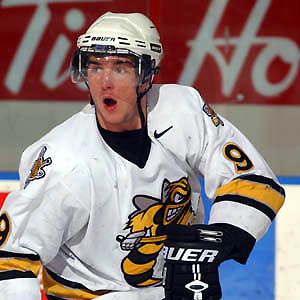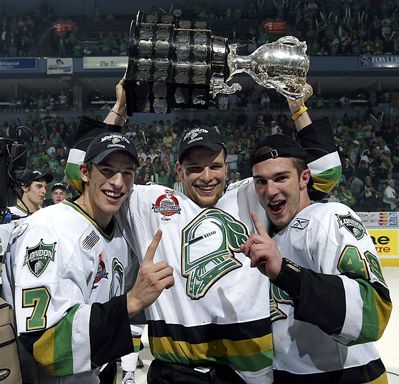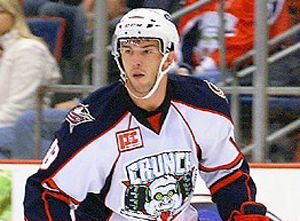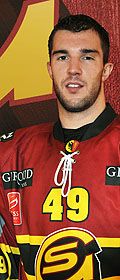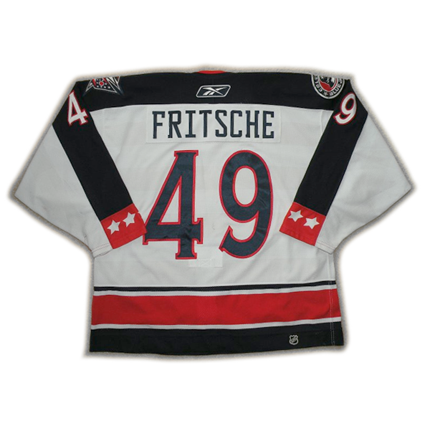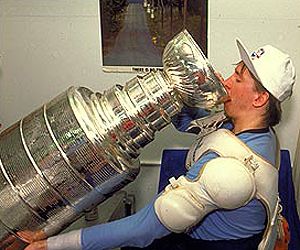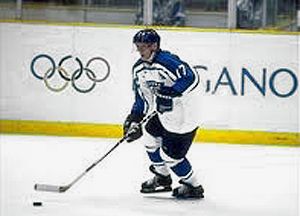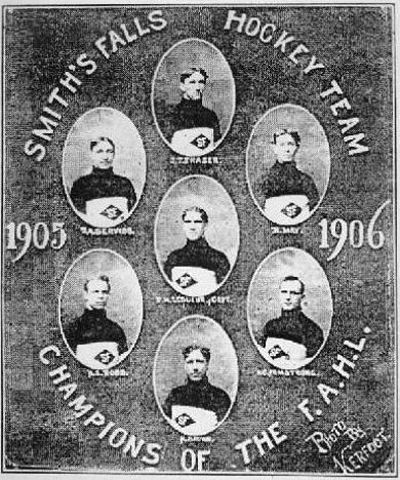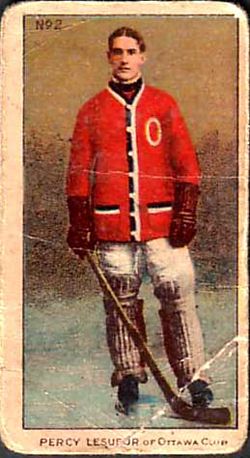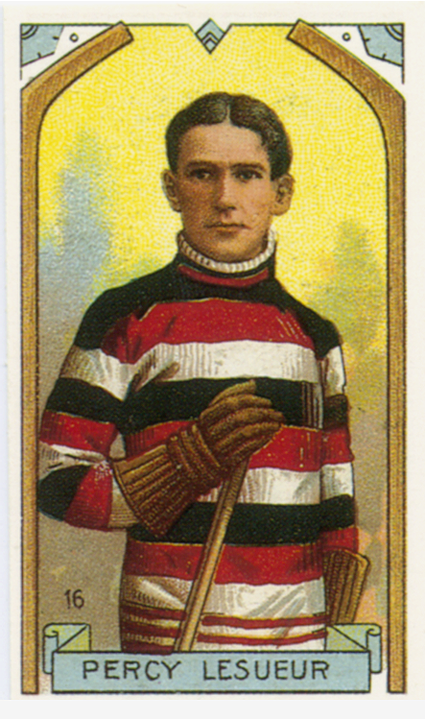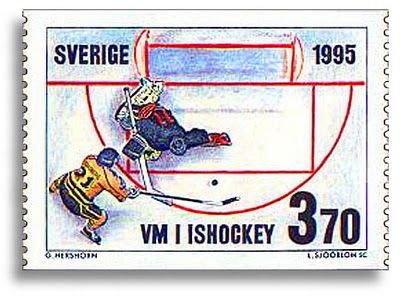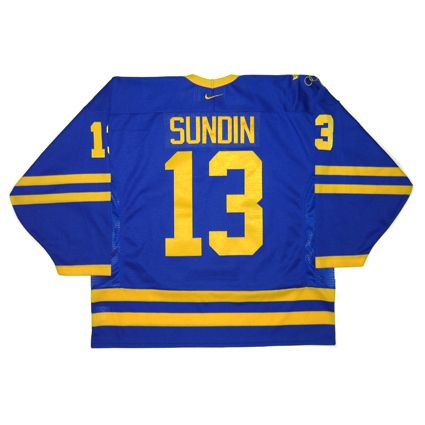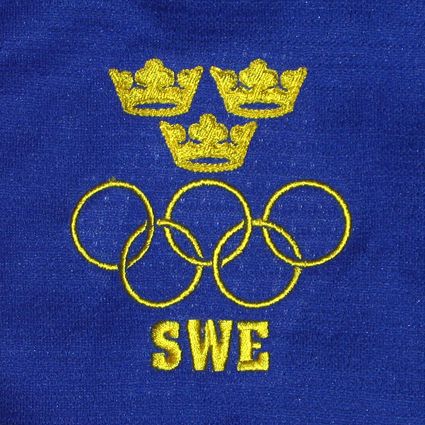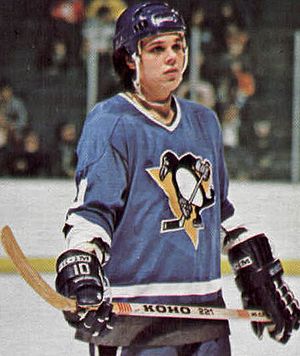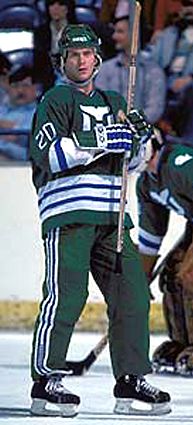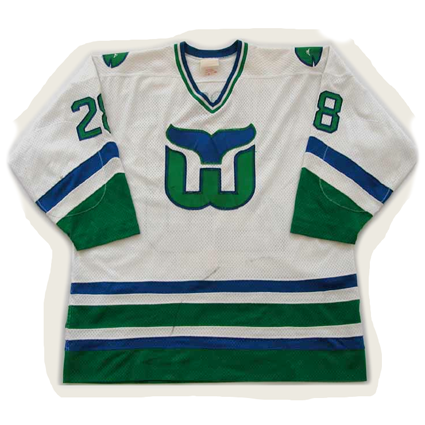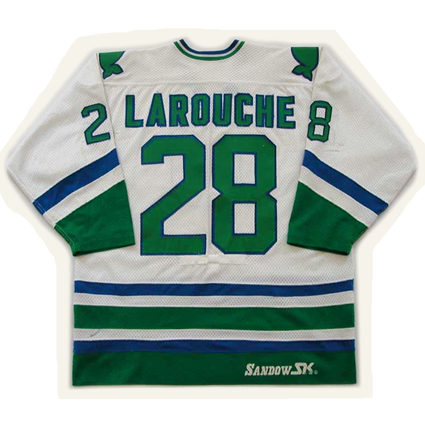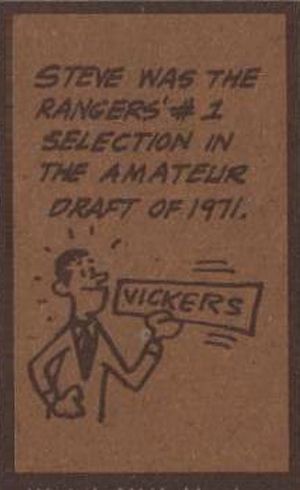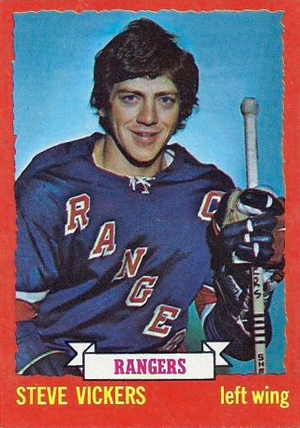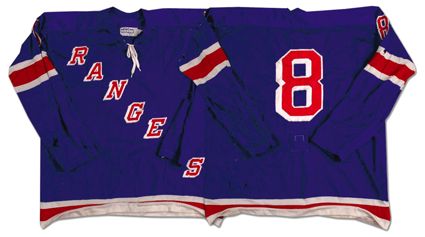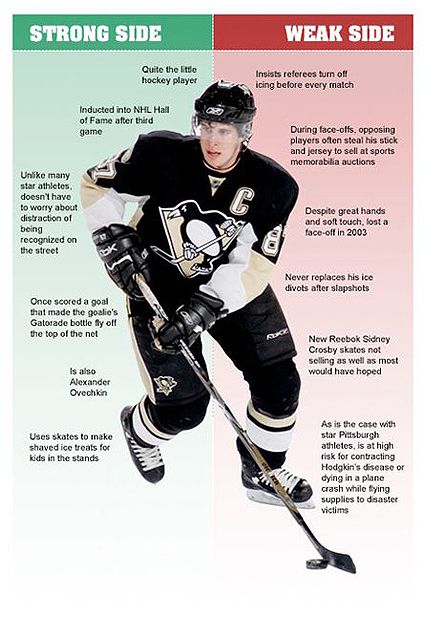Saturday, November 20, 2010
2006-07 Columbus Blue Jackets Dan Fritsche Jersey
Dan Fritsche was born in the Cleveland suburb of Parma, Ohio in 1985 and played junior hockey with the Cleveland Jr. Barons of the NAHL in 2000-01. From there he moved to the Sarnia Sting of the Ontario Hockey League in Canadian Junior hockey.
Fritsche played 61 games with Sarnia in 2002-03, scoring 32 goals and 71 points in 61 games which led to the Ohioan being drafted 46th overall in the second round of the 2003 NHL Entry Draft by the Columbus Blue Jackets.
Fritsche with the Sarnia Sting
He generated quite a number of game worn jerseys in 2003-04 by first earning a roster spot in training camp with the Blue Jackets. He played in 19 games, which included scoring his first NHL goal on this date in 2003, making him the first Ohio native to score a goal for the Columbus Blue Jackets.
At Christmas time, Fritsche joined Team USA at the World Junior Championships in Helsinki, Finland where he score four points in six games as the United States captured the gold medal over Canada 4-3 in the final.
At the conclusion of the World Juniors, Fritsche was returned to Sarnia by the Blue Jackets, where he woudl score 29 points in 27 games. Once Sarnia's season concluded, Fritsche joined the Blue Jackets top minor league club, the Syracuse Crunch of the AHL for the final four regular season games plus four additional playoff games.
With the 2004-05 lockout taking away the NHL season, Fritsche returned to Sarnia once more, but was traded to the London Knights. He scored 35 points in 28 regular season games for the high powered Knights, who finished the regular season with a dominant 59-7-2 record. London blitzed the OHL in the playoffs and Fritsche contributed 22 points in 17 playoff games, fourth on the club, as they captured the 2005 Memorial Cup.
Drew Larman, Robbie Schremp, and Dan Fritsche celebrate the London Knights Memorial Cup championship in 2005
With the NHL back in business for 2005-06, Fritsche split time with Syracuse (19 games) and Columbus, where he played in 59 games and scored six goals and 13 points. He would stick with the Blue Jackets for the next two seasons, with his best being 2006-07 when he scored 12 goals and 27 points while seeing action in 59 games.
Following the 2007-08 season, Fritsche was included in a trade along with Nikolai Zherdev to the New York Rangers. He found little ice time waiting for him in New York and got into only 16 games with the Rangers by late January prior to being traded to the Minnesota Wild, where he played in 34 games and scored nine points.
He became a free agent at the conclusion of the season and signed with the Blue Jackets organization, once more returning to Syracuse where he played 67 games with the Crunch, scoring 42 points, good for second on the team.
Fritsche during his return to Syracuse in 2009-10
At the start of the 2010-11 season, Fritsche followed the footsteps of his uncle John Fritsche, and played in Switzerland for Geneve Servette in the Swiss National League A.
Fritsche wearing the colors of Geneve Servette
Through the end of last season, Fritsche remains the highest scoring Ohio native in Blue Jackets history, with 63 points in 206 games, 22nd overall in the nine seasons of the club. Other Ohioans to have skated for the Blue Jackets are Brett Harkins (from North Ridgeville, 14 points in 25 games in 2001-02), Mike Rupp (Cleveland, 6 pts in 39 games in 2005-06), Brian Holzinger (Parma, 1 point in 13 games in 2003-04) and Ben Simon (Shaker Heights, no points in 13 games in 2005-06).
Today's featured jersey is a 2006-07 Columbus Blue Jackets Dan Fritsche jersey. The Blue Jackets original jerseys featured cartoonish secondary logo of the head of their team mascot "Stinger". Their jerseys were originally made by CCM/Koho and were adorned with the Blue Jackets Inaugural Season patch.
For 2003-04, an alternate jersey was introduced with a new main logo and Stinger was replaced on the shoulders of the home and road jerseys with the new alternate jersey logo on the left shoulder and a Civil War cap on the right.
Coming out of the lockout, the jerseys remained the same, but were now branded as Reebok for two seasons before the league-wide wholesale change to the Edge jerseys beginning in 2007.
Today's video segment is Fritsche scoring on a breakaway during a delayed penalty call while with the Minnesota Wild.
Labels:
Columbus Blue Jackets,
Fritsche Dan
Friday, November 19, 2010
1988-89 Edmonton Oilers Jari Kurri Jersey
It was on this date in 1983 at home in Edmonton versus the New Jersey Devils and goaltenders Ron Low and later Glenn Resch that Jari Kurri scored five goals in a single game, still the only Finnish player to ever do so in an NHL game. The five goals in one game is an Oilers record he shares with Wayne Gretzky and Pat Hughes.
Kurri also holds the Oiler record for Most Points in One Period with five, on two goals and three assists versus the Los Angeles Kings on October 26, 1984 against Darren Eliot, and shares the Oiler record for Most Assists in One Period with four in the second period against the Winnipeg Jets and goaltender Bryan Hayward on October 7, 1983, which is also the NHL record as well.
Other Oiler records to Kurri's credit are;
- Most Points in One Season by a Right Wing - 135
- Most Goals in One Season by a Right Wing - 71
- Most Points in One Season by a Rookie - 75
- Most Assists in One Season by a Rookie - 41
- Most 20 Goal Seasons - 10
- Most Consecutive 20 Goal Seasons - 10
- Most 30 Goal Seasons - 10
- Most Consecutive 30 Goal Seasons - 10
- Most Career Playoff Goals - 92
- Most Playoff Goals by a Rookie - 5
- Most Playoff Goals in One Game - 4
- Most Game-Winning Goals in One Playoff Year - 5
- Most Playoff Points by a Rookie - 12
- Most Career Playoff Power Play Goals - 22
- Most Shorthanded Goals in One Playoff Series - 2
- Most Shorthanded Goals in One Playoff Game - 2
Kurri is second in Oiler history in career goals with 474, third in career assists with 569, second in career points at 1,043.
He is fourth in single season goals with 71, third in career playoff assists with 110, third in career playoff points with 202. His 19 goals in one playoff year is also he NHL record.
Other NHL records Kurri holds are;
- Most Hat Tricks in One Playoff Year - 4
- Most Hat Tricks in One Playoff Series - 3
- Most Goals in One Playoff Series - 12
- Most Power Play Goals in One Playoff Game - 3
- Most Shorthanded Goals in One Playoff Period - 2
- Most Points by a European-born and Trained Player - 1,398
Kurri finished his NHL career with five Stanley Cup Championships the 1985 Lady Byng Trophy, 601 goals, 797 assists and 1398 points in 1251 games.
Kurri shares a moment with an old friend
Internationally, Kurri played in the World Junior Championships twice, in 1979 and again in 1980, earning a silver medal while scoring the most points, the European Junior Championships in 1978 winning gold and being named Best Forward of the tournament. He also competed for Finland in the Canada Cup in 1981, 1987 and 1991, the 1996 World Cup of Hockey where he was team captain, the World Championships in 1982, 1989, 1991 and 1994, when he earned a sliver medal, as well as the Winter Olympics in 1998, earning a bronze medal.
Kurri on his way to winning a bronze medal at the 1998 Olympics
His #17 was retired by Jokerit Helsinki, the Edmonton Oilers and the Finnish National Team. He was inducted into the Finnish Hockey Hall of Fame in 1998, the IIHF Hall of Fame in 2000 and the Hockey Hall of Fame in 2001.
Today's featured jersey is a CCM 1988-89 Edmonton Oilers Jari Kurri jersey and features the Edmonton Oilers 10th Anniversary patch. This is a bit of an odd patch since the Oilers were founded in 1972 as one of the original members of the WHA. This would make 1988-89 the Oilers 16th Anniversary season. This patch was clearly meant to commemorate the Oilers 10th Anniversary of joining the NHL following the demise of the WHA in 1979, a league the NHL chooses to pretend never actually existed.
There is also an image of a single Stanley Cup in the patch, but the Oilers had actually won four cups at that point, something most teams would have probably driven home by putting multiple images of the cup on the patch, as the Islanders would do three seasons later.
Labels:
Edmonton Oilers,
Kurri Jari
Thursday, November 18, 2010
1910-11 Ottawa Senators Percy LeSueur Jersey
Goaltender Percy LeSueur was born in Quebec City, Quebec on this day in 1881. He was a member of the 1903-04 Smith Falls Seniors of the Ontario Hockey Association, where the right winger converted to goaltender, going 3-3 in six games played, and stayed with the club the following season when they moved to the Federal Amateur Hockey League. Smiths Falls won the league title by going a perfect 7-0 with LeSueur winning all seven games while posting a 1.9 goals against average, far ahead of the next best goalkeeper's 4.5 average.
Smiths Falls, encouraged by their strong performance in the FAHL, challenged the current Stanley Cup holders, the Ottawa Senators. Ottawa won the first game of their best-of-three series 6-5 on March 6, 1906 and successfully defended their rights to the cup two days later with an 8-2 win. Despite the 14 goals scored against Smiths Falls in the two games, the Senators were so impressed by LeSueur that they obtained his rights and he made his Senators debut just nine days later.
At the time the Senators were involved in another playoff series for the championship of the Eastern Canada Amateur Hockey Association against the Montreal Wanderers, with whom they had tied for the league lead with matching 9-1 records, with the league champion also earning possession of the Stanley Cup. Following Montreal's dominant 9-1 win in the first game of the two-game total-goals series, LeSueur was installed in the Senators goal. Anticipation for the game was high, attracting a crowd of over 5,400 people, which resulted in all manner of changes to the Dey's Arena seating to accommodate the throng, some of which paid five times face value for a ticket to the match, a lofty $10!
Facing an enormous task being down by eight goals, the Senators made things harder for themselves by giving up the first goal of the game, raising their deficit to nine. The Senators responded by scoring three goals prior to halftime, and Ottawa then stormed out in the second half, piling up six straight goals to even the series at ten goals apiece! Montreal's Lester Patrick would dash the Senators dream of a comeback by scoring with a minute and a half to play and clinch the title with another with seconds left on the clock, ending the Silver Seven's three year reign as holders of the Stanley Cup, which included nine straight successful defenses.
The Toronto Globe would call the game the "greatest game of hockey ever played on Canadian ice, or any other", while The Sporting News labeled it the "Greatest Hockey Game in History".
In his first two full seasons of 1906-07 and 1907-08 with Ottawa, LeSueur posted identical 7-3 records before he lead Ottawa to the league title in 1908-09 when he went 10-2. By winning the league championship, Ottawa regained their role as holders of the Stanley Cup for the first time since losing control of the cup in LeSueur's memorable first game as a Senator in 1906.
During this time period, he was also chosen to play goal in the Hod Stuart Memorial Game, the first All-Star game in hockey history on January 2, 1908.
The next season was one of turmoil for Ottawa off the ice, as they joined the ill-fated Canadian Hockey Association for a few weeks prior to moving over to the National Hockey Association. During the season, the Senators successfully defended two separate challenges to their rights to the Stanley Cup, with LeSueur winning all four games, two against Galt and two against Edmonton. Back in the NHA, at the end of the season Ottawa had finished second in the seven team league, forcing them to relinquish the cup to the Wanderers once more.
Ottawa regained the cup following the 1910-11 season in which LeSueur went 13-3 and then withstood two single game challenges from Galt (7-4) and the Port Arthur Bearcats (13-4), giving LeSueur a six game winning streak in Stanley Cup challenge games.
1910-11 Ottawa Senators - holders of the Stanley Cup
LeSueur is in the center of the photo holding his goalie stick and wearing the leg pads
LeSueur would spend three more seasons with the Senators before being traded to the Toronto Shamrocks for the 1914-15 season and transferred to the Toronto Blueshirts for the final season of his playing days.
LeSueur was an innovator, being credited for the design of the hockey net used on the ice from 1912 to 1925 and the "gauntlet" style goaltending glove. He later coached the Hamilton Tigers of the NHL in 1923-24 and was a member of the broadcast team of Hockey Night in Canada during it's early days while still on the radio. He was also a member of the ownership group which won the rights to an NHL franchise for the city of Detroit, originally named the Cougars, who coincidentally played their first game also on this date in 1926.
LeSueur was inducted into the Hockey Hall of Fame in 1961.
Today's featured jersey is a 1910-11 Ottawa Senators Percy LeSueur jersey with the Senators trademark black, red and white horizontal "barberpole" stripes. This style of jersey was first adopted in 1904, and except for one season with vertical stripes in 1910-11, remained in use through the original Senators final season in Ottawa of 1933-34, with the addition of the letter "O" crest from 1929-30 on.
Labels:
LeSueur Percy,
Ottawa Senators
Wednesday, November 17, 2010
2006 Sweden National Team Mats Sundin Jersey
On this date in 1922, the Swedish Ice Hockey Association was founded. The administration of Swedish ice hockey had previously been a part of the Swedish Football Association, which allowed Sweden to gain membership in the International Ice Hockey Federation back in 1912.
Sweden has a long and illustrious history to draw on for today's video selections, and we begin with a look at several of the gold medals Sweden has won since 1987.
Sweden's first international participation came in the 1920 Olympic games, with a 4th place finish. Since then they earned a silver medal in 1928, a bronze 24 years later in 1952 and a silver in 1964. At this point the "Tre Kroner" (Three Crowns), as the team in known, had won three medals in 11 tries spanning 52 years. After skipping the 1976 Olympics, Sweden entered a new era of competitiveness and earned the first of three consecutive bronze medals in 1980, followed by others in 1984 and 1988. They came in 5th in 1992 before finally earning their first Olympic gold medal in 1994 thanks to Peter Forsberg's memorable shootout goal, which was later immortalized on a postage stamp.
After another pair of fifth place finishes in 1998 and 2002, Sweden once more came home with gold following the 2006 games after defeating their Nordic neighbors and rivals Finland 3-2. Their most recent finish of 5th earlier this year in Vancouver, while not a medal finish, kept alive their streak of never finishing lower than 5th in 20 Olympics dating back 90 years.
Sweden entered the World Championships for the first time in 1931 and won their first medal in 1947 with a silver. Considered one of the World's elite hockey nations, Sweden has never been outside of the Top Division of the World Championships in their history, with medal winning finishes coming more often than not.
The Swedes have captured the World Championship eight times, the most recent being in 2006 in Latvia. That championship victory, coupled with their Olympic gold medal championship three months earlier, made Sweden the first team to ever win both the Olympics and World Championships in the same year. They have also won World Championship silver 16 times and bronze an additional 15 times, including the most recent tournament in 2010.
Considered one of the World's elite teams, Sweden has also participated in the six team Canada Cup tournaments all five times it was held, with a best finish of second in 1984, and the eight team World Cup of Hockey twice, reaching the semi-finals in 1996.
Today's featured jersey is a 2006 Sweden National Team Mat Sundin jersey. Sweden's jerseys adorned with the three crowns are the most traditional of all the national team jerseys, similar to the Montreal Canadiens in that they remain essentially unchanged with only minor tweaks throughout their history and are more resistant to manufacturer trends than other countries. Sweden, in fact, won the last Olympics in 2006 wearing regular style jerseys, while every other country, save Swizterland, was wearing the supposed performance enhancing Nike Swift jerseys for the first time.
While Sweden is best known for their bright yellow home jerseys, and seem to wear them in a disproportionate amount of their games, they won the 2006 Olympic gold medal while wearing today's featured jersey, their blue road jerseys.
Sweden has a long and illustrious history to draw on for today's video selections, and we begin with a look at several of the gold medals Sweden has won since 1987.
Here is the conclusion of the shootout in the gold medal game at the 1994 Olympics in Lillehammer, Norway, which included Forsberg's famous goal.
In 2006, Sweden became the first country to win both the Olympics and the World Championships in the same season.
Here are highlights of the Gold Medal game against rivals Finland.
And here they celebrate the historic double by winning the World Championships three months later.
Tuesday, November 16, 2010
1978-79 Montreal Canadiens Pierre Larouche Jersey
Born on this date in 1955, Pierre Larouche began his junior hockey career with the Quebec Remparts of the QMJHL in 1972. There, he scored 13 points in 20 games before moving over to the Sorel Black Hawks, where he announced his presence with 47 goals, plus 54 assists, for 101 points in just 43 games.
The next season he buried the accelerator and won the Jean Beliveau Trophy as the league's leading scorer when he scored 251 points from 94 goals and 157 assists in 67 games, an average of 3.75 points and 1.4 goals per game. His 251 points were a league record which stood for ten years until surpassed by Mario Lemieux's 282 in 70 games.
Despite his record setting point totals in juniors, Larouche was not picked until the eighth selection of the 1974 NHL Amateur Draft by the Pittsburgh Penguins, the fifth forward taken.
He adjusted to the NHL game quickly, and after scoring 31 goals and 68 points as a rookie, Larouche became only the 16th player in league history to score 50 goals in a season, which he accomplished in just his second year of professional hockey, with 53 goals in 1975-76. Additionally, he had even more assists, 58, for 111 points for fifth place in that year's scoring race. His 50 goals and 100 points made him the youngest player to ever accomplish both feats.
Limited to 65 games the following season, his point totals dropped to 63, and following the Penguins quick exit from the playoffs, Larouche was a member of Team Canada at the 1977 World Championships, Canada's first world championship following their boycott due to the rules on professionalism.
After 20 games of the 1977-78 season, the French-Canadian Larouche was acquired by the Montreal Canadiens in exchange for Peter Mahovlich and Peter Lee. Larouche was an odd fit under the guidance of head coach Scotty Bowman, who was not the greatest fan of Larouche's frankly offense only style of play. Still, it was a good time to join the Canadiens and after 49 points in 44 games, Larouche won a Stanley Cup ring as a member of the champions.
The following season was more of the same, limited playing time and another championship, as Larouche only saw action in 36 games. Things changed however, when Bowman left the Canadiens and was replaced by "Boom Boom" Geoffrion, who knew a thing or two about goal scoring himself.
Freed of Bowman's control, Larouche was again free to play his style of game and responded with the second 50 goal season of his career, the first player to ever score 50 goals for two different teams. After one more season in Montreal, Larouche was traded to the Hartford Whalers after playing 22 games for the Canadiens in 1981-82.
Larouche would play 83 games for Hartford over the course of the next two seasons and then sign with the New York Rangers as a free agent in time for the 1983-84 season. His new surroundings energized Larouche after playing with the cellar dwelling Whalers, and he scored 48 goals and 81 points in 77 games, yet he was a -15 in plus/minus. The next year followed the same pattern, with 60 points in 65 games and a -17 rating.
The Rangers sent Larouche to the minors for the start of the 1985-86 season. While with the Hershey Bears of the AHL, he scored 20 goals in 32 games before being recalled by the Rangers, where he scored 28 goals and 63 points in 73 games, one of the few players to score 20 goals in two leagues in the same season. His career wrapped up with 12 points in 10 games of the 1987-88 season before Larouche retired.
Today's featured jersey is a 1978-79 Montreal Canadiens Pierre Larouche jersey worn during the season when Larouche won his second Stanley Cup as a member of the Canadiens dynasty of the 1970's.
While not as famous as the Canadiens iconic red jerseys, the white Montreal jersey first appeared in 1935 and gained it's red shoulders in 1941. Aside from a brief three year run in the mid 1940's where the Canadiens jerseys had white shoulders and a blue band around the chest, a style now often worn by Montreal as a throwback or alternate style, the white jersey with red shoulders has remained in use for nearly 70 years.
Bonus Jersey: Today's bonus jersey is a 1982-83 Hartford Whalers Pierre Larouche jersey. This style of jersey was used from their entry into the NHL in 1979 through 1985 and is infamous for having been one of only two NHL jerseys to have been worn with the controversial Cooperalls, the full-length pants that proved to be too radical for the tradition-leaden NHL. The pants were eventually banned in the name of safety, as the slick, slippery fabric they were constructed from regularly sent players skidding into the boards, but in our opinion made the players look taller, sleeker and faster.
Why players would ever wear short pants for a winter sport, we will never quite understand...
In today's video segment, a profile of Larouche while a member of the Hartford Whalers. Be sure to note the size of his wife's hair and a glimpse of the Cooperalls in action.
Labels:
Hartford Whalers,
Larouche,
Montreal Canadiens
Monday, November 15, 2010
1972-73 New York Rangers Steve Vickers Jersey
Left winger Steve Vickers was drafted 10th overall by the New York Rangers in the 1971 NHL Amateur Draft following his two seasons with the Toronto Marlboros of the Ontario Hockey Association. In his last season with the Marlboros, Vickers was named a First Team All-Star following his 43 goal, 107 point season.
Prior to playing with the Rangers, Vickers spent a year in the minors with the Omaha Knights of the Central Hockey League where he scored 59 points in 70 games in his first season as a professional.
Vickers made his NHL debut during the 1972-73 season and wasted little time making a name for himself. In just the Rangers 16th game of his rookie season, Vickers got a hat trick in a 5-1 win on November 12, 1972 versus the Los Angeles Kings.
What Vickers did next, not only helped make a name for himself, it got his name into the NHL record book, when during his very next game on this date in 1972, Vickers became the first rookie in the 56 year history of the NHL to score hat tricks in consecutive games, but also the first Ranger to ever do so, as part of a 7-2 Rangers win over the Philadelphia Flyers.
Vickers, playing on a line with Walt Tkaczuk and Bill Fairbairn, finished the 1972-73 season with 61 games played (out of a possible 78) and scored 30 goals and 53 points. He also contributed five goals and nine points in ten playoff games for the Rangers during his rookie season, which was capped off in fine style when he was named the recipient of the NHL's 1973 Calder Trophy.
Steve Vickers 1973-74 OPC rookie card
His 30 goal season was the first of four to open his career. Vickers would spend his entire 10 year NHL career with the Rangers with his best season being 1974-75 when he would post career highs in goals, with 31, and points, with 89. He would reach the Stanley Cup Finals once, that being the 1979 edition and played in the NHL All-Star Game in 1975 and 1976.
While he would not reach 30 goals during his final six seasons of play, he, Tkaczuk and Fairbairn were regarded as one of the best two-way forward lines in the games.
At the conclusion of his career, Vickers competed in 698 games, scoring 246 goals and 340 assists for 586 points and earned himself a permanent place in the NHL record book with his consecutive hat tricks during the first five weeks of his career.
Today's featured jersey is a 1972-73 New York Rangers Steve Vickers jersey. Names had yet to appear full time on the Rangers jerseys at the time of Vickers rookie season. In fact, the Rangers changed to their short-lived shield logo modern jerseys in 1976 before reverting to their classic, diagonally crested jerseys in 1978, only now with "New York" on the front, meaning Vickers never wore his name on the back of a blue jersey with "Rangers" on the front, as that style did not reappear until 1987, five years after Vickers retirement.
Our video selection today is an interview with Vickers from January of 2010.
Here is the fight Vickers refers to against Don Marcotte of the Boston Bruins during Vickers rookie season in which he scores a clear decision.
Labels:
New York Rangers,
Vickers Steve
Sunday, November 14, 2010
Subscribe to:
Comments (Atom)

